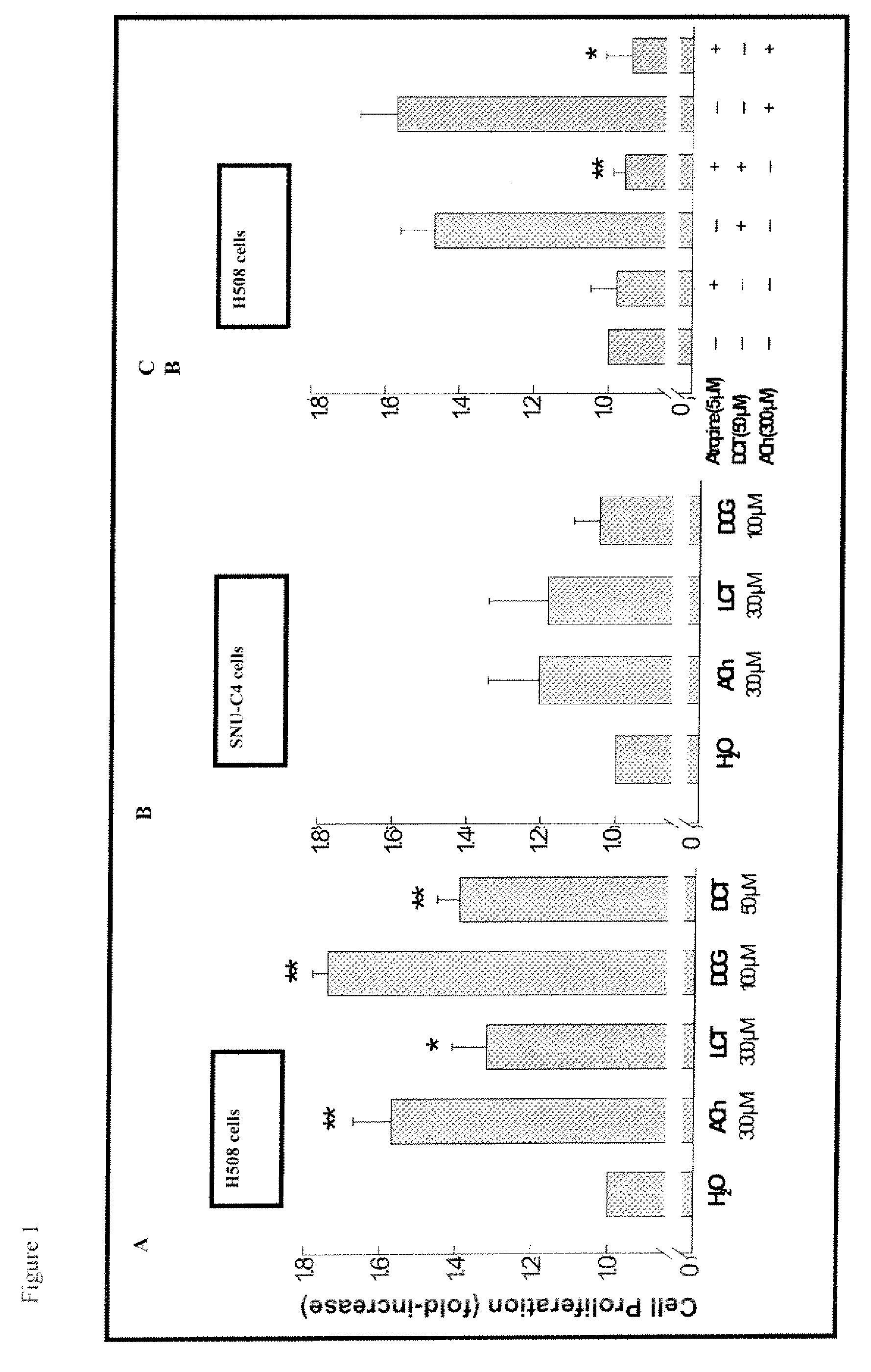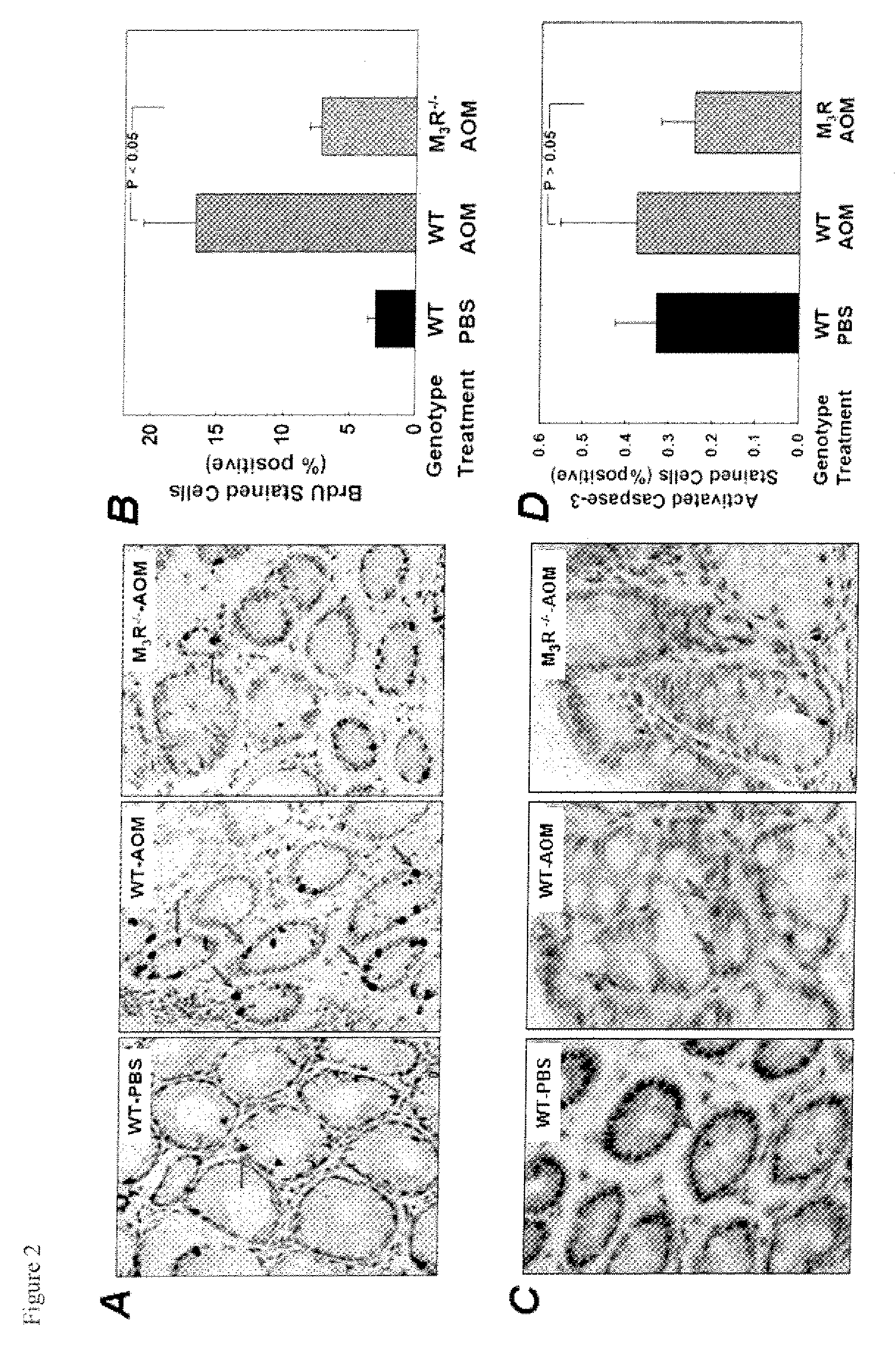Treatment of cancer with Anti-muscarinic receptor agents
- Summary
- Abstract
- Description
- Claims
- Application Information
AI Technical Summary
Benefits of technology
Problems solved by technology
Method used
Image
Examples
example 1
[0075]Cells that are known to express both EGFR and M3R were treated with several M3R antagonists and bile acid conjugates to determine if M3R ligand binding affected EGFR activation. H508 cells (A,C) and SNU-C4 cells (B) were treated with ACh, LCT, DCG, or DCT (5 days, 37° C.) alone (A,B) or with atropine (C). Cell proliferation was determined using the sulforhodamine B (SRB) colorimetric assay. As shown in FIG. 1, ACh, lithocholic and deoxycholic acid conjugates stimulate proliferation of H508 cells that co-express M3R and EGFR, but do not significantly alter proliferation of SNU-C4 cells that express EGFR but not M3R. As observed, actions of DCT are inhibited by atropine. Mean±SEM of 3 exp. (A): *,** significantly greater than water (p<0.05 and 0.001, respectively, unpaired Student's Mest). (C): *,** significantly less than DCT or ACh alone (p<0.05 and 0.001, respectively).
example 2
[0076]WT and M3R− / − male mice (129S6 / SvEvTac×CFl; 50% / 50%) were treated for 6 wks in which 48 animals received weekly intraperitoneal (ip) PBS (control) or AOM (10 mg / kg). The AOM mouse model is a well-established, commonly used model that mimics human colon carcinogenesis. AOM, an intermediate in the metabolism of 1,2-dimethylhydrazine to the alkylating ion methyldiazonium, is a well-known colorectal-specific pro carcinogen. AOM-induced rodent tumors mimic human colon cancer in that most tumors arise in the colon, form grossly visible exophytic polypoid or plaque-like growths, and have a microscopic appearance similar to that of human lesions. Molecular changes in AOM-induced tumors, including β-catenin and p53 mutations, which also mimic those in human colon cancer. To determine tumor incidence, mice were observed for a full 20 wks. Short-term study end-points are identified (e.g. aberrant crypt foci (ACF), β-catenin-accumulating crypts (BCAC) and BrdUrd staining) and potential to...
example 3
[0087]Deoxycholyltaurine(DCT) conjugates stimulate colon cancer cell muscarinic signaling and proliferation
[0088]MAPK activation was detected with 10 μM and maximal with 300 μM DCT. The proliferation of H508 cells, which are cells that express muscarinic M3 receptors, was stimulated after 5 days and was detected over the same range of concentrations that activates MAPK. DCT-induced MAPK activation is rapid and reversible. MAPK activation is detected within 1 min, maximal by 10-20 min and returns to basal by 70 min. Collectively these findings emphasize the importance of co-expression of M3R and EGFR for both ACh- and bile acid-induced colon cancer cell proliferation, and define relevant DCT concentrations.
PUM
| Property | Measurement | Unit |
|---|---|---|
| Fraction | aaaaa | aaaaa |
Abstract
Description
Claims
Application Information
 Login to View More
Login to View More - R&D
- Intellectual Property
- Life Sciences
- Materials
- Tech Scout
- Unparalleled Data Quality
- Higher Quality Content
- 60% Fewer Hallucinations
Browse by: Latest US Patents, China's latest patents, Technical Efficacy Thesaurus, Application Domain, Technology Topic, Popular Technical Reports.
© 2025 PatSnap. All rights reserved.Legal|Privacy policy|Modern Slavery Act Transparency Statement|Sitemap|About US| Contact US: help@patsnap.com



